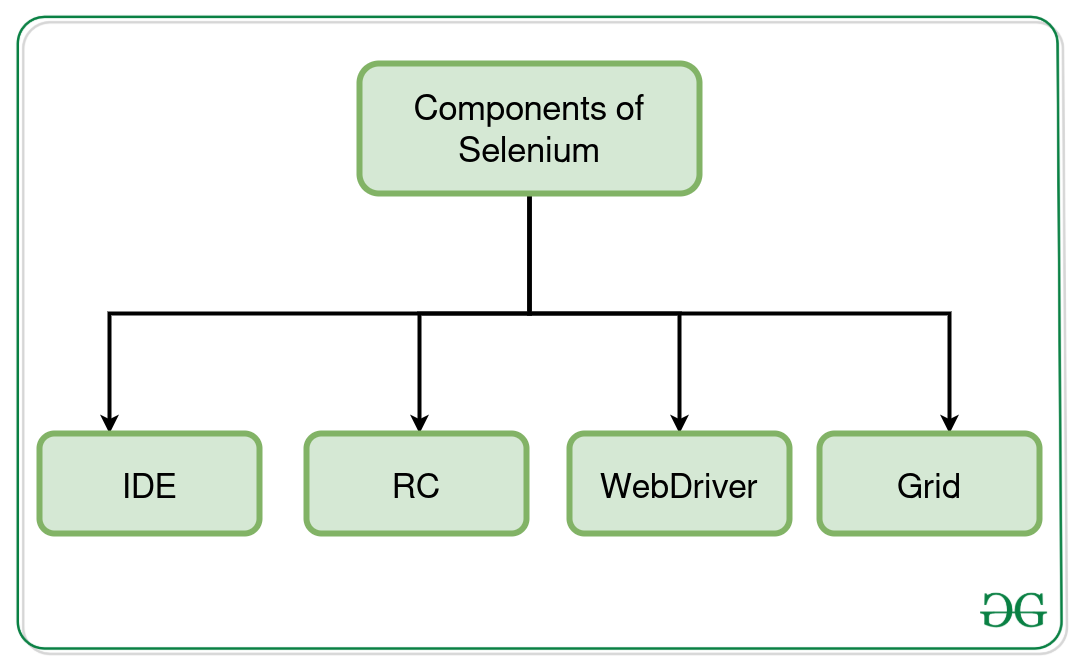Components of Selenium
Last Updated :
01 May, 2024
Selenium is a powerful tool for controlling web browsers through programs. It is functional for all browsers, works on all major OS, and its scripts are written in various languages i.e. Python, Java, C#, etc, we will be working with Python. Selenium has four major components – Selenium IDE, Selenium RC, Selenium Web driver, and Selenium GRID.

Components of Selenium
Selenium has been in the industry for a long time and used by automation testers all around the globe. Let’s check the four major components of Selenium
Selenium IDE
Selenium IDE (Integrated Development Environment) is the major tool in the Selenium Suite. It is a complete integrated development environment (IDE) for Selenium tests. It is implemented as a Firefox Add-On and as a Chrome Extension. It allows for recording, editing and debugging of functional tests. It was previously known as Selenium Recorder. Selenium-IDE was originally created by Shinya Kasatani and donated to the Selenium project in 2006. Selenium IDE was previously little-maintained. Selenium IDE began being actively maintained in 2018. Scripts may be automatically recorded and edited manually providing autocompletion support and the ability to move commands around quickly. Scripts are recorded in Selenese, a special test scripting language for Selenium. Selenese provides commands for performing actions in a browser (click a link, select an option) and for retrieving data from the resulting pages.
IDE is an easy-to-use tool that can even be used by beginners for developing automated test cases for web applications. Working with IDE is very simple we have to give the URL of the website on which we have to create tests. Then press a recording and as soon as the recording starts the website will be loaded and then we can do any operation like clicking on the buttons, fields, and submitting a form.
While doing this IDE will catch the interactions and it will show on screen. Based on these interactions we can generate a script in different languages for future purposes.

Demo of Selenium IDE
Selenium RC (Remote control)
Selenium Remote Control (RC) is a server, written in Java, that accepts commands for the browser via HTTP. RC makes it possible to write automated tests for a web application in any programming language, which allows for better integration of Selenium in existing unit test frameworks. To make writing tests easier, Selenium project currently provides client drivers for PHP, Python, Ruby, .NET, Perl and Java. The Java driver can also be used with JavaScript (via the Rhino engine). An instance of selenium RC server is needed to launch html test case – which means that the port should be different for each parallel run. However, for Java/PHP test case only one Selenium RC instance needs to be running continuously.
Selenium Web Driver
Selenium WebDriver is the successor to Selenium RC. Selenium WebDriver accepts commands (sent in Selenese, or via a Client API) and sends them to a browser. This is implemented through a browser-specific browser driver, which sends commands to a browser and retrieves results. Most browser drivers actually launch and access a browser application (such as Firefox, Google Chrome, Internet Explorer, Safari, or Microsoft Edge); there is also an HtmlUnit browser driver, which simulates a browser using the headless browser HtmlUnit. Selenium WebDriver does not need a special server to execute tests. Instead, the WebDriver directly starts a browser instance and controls it. However, Selenium Grid can be used with WebDriver to execute tests on remote systems (see below). Where possible, WebDriver uses native operating system level functionality rather than browser-based JavaScript commands to drive the browser. This bypasses problems with subtle differences between native and JavaScript commands, including security restrictions.
Selenium GRID
Selenium Grid is a server that allows tests to use web browser instances running on remote machines. With Selenium Grid, one server acts as the hub. Tests contact the hub to obtain access to browser instances. The hub has a list of servers that provide access to browser instances (WebDriver nodes), and lets tests use these instances. Selenium Grid allows running tests in parallel on multiple machines and to manage different browser versions and browser configurations centrally (instead of in each individual test). The ability to run tests on remote browser instances is useful to spread the load of testing across several machines and to run tests in browsers running on different platforms or operating systems. The latter is particularly useful in cases where not all browsers to be used for testing can run on the same platform.
Share your thoughts in the comments
Please Login to comment...